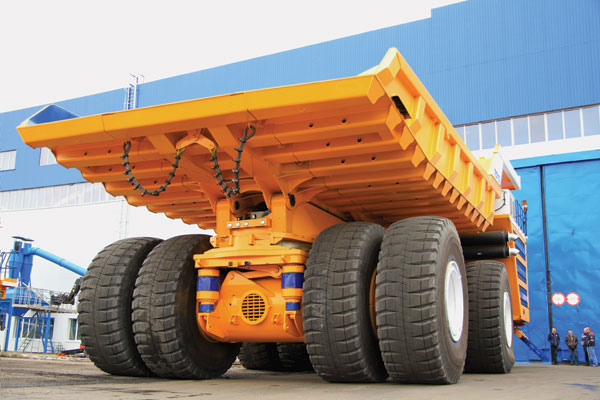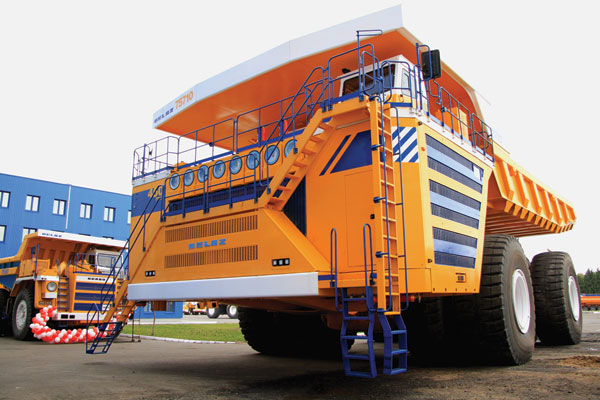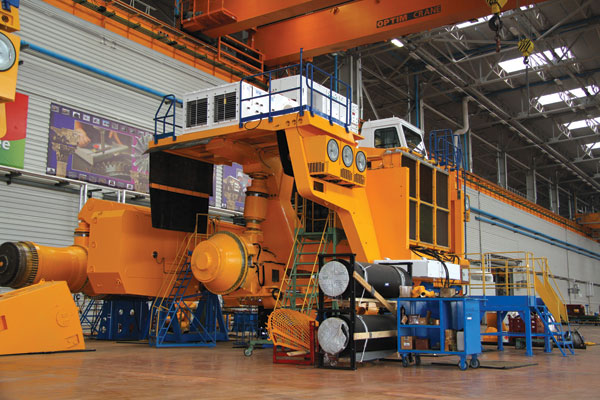But, the space required to house two 2,500-hp diesel engines makes the recently unveiled BelAZ 450-mt hauler appear nose-heavy from the front.
At the end of September, Belarusian engineering firm BelAZ, which manufactures mining machinery, unveiled the 450-metric ton (mt) BelAZ-75710 haul truck — the industry’s largest hauler. More than an engineering achievement for BelAZ, the haul truck has also caught the attention of several major multinational mining companies.
“At BelAZ, we create our equipment based on two main principles: the amount of mining will only grow with time, and the capacity of mining equipment will increase constantly and steadily,” said Alexander Egorov, general designer and head of research and development for BelAZ. “Accepting these principles, we concluded that we should create a machine with the largest capacity. Prior to this project, BelAZ had successfully made and marketed 360-mt haul trucks. Several mining companies in Russia are currently using these trucks.”
The BelAZ-75710 is the first in a new class of heavy-duty trucks, according to Oleg Stepuk, chief engineer for BelAZ. The designers of the new machine decided early in its development process to move away from the traditional concept of haul truck production. With this project, the designers wanted to achieve reliability, compactness and a significant capacity increase of truck in conjunction with all applicable safety standards, according to Stepuk.
The new truck has several unique features. In particular, the designers achieved the record capacity through the use of eight tires. Egorov said BelAZ attained the maximum possible weight of the truck.
“The design of every haul truck begins with the tires,” Egorov said. “The tires that were used for the development and construction of the 75710 have the highest capacity created so far, so the idea was to increase the capacity by increasing the number of tires.” According to Egorov, the tire industry is able to offer tires that can withstand a maximum load of 102 mt. Eight wheels with radial tubeless pneumatic tires located in pairs on the two axles can support 816 mt. The weight of the fully loaded BelAZ-75710 will be about 810 mt.
Using a combination of experience and innovative technical solutions, BelAZ managed to confine the new trucks to the same limits, such as haul road width, under which current 320- to 360-mt haul trucks operate. Trucks are useless, however, unless they can move about freely and the designers achieved acceptable maneuverability through the use of two articulation points — both axles steer. The turning radius for the new truck is 19.8 m, compared to 17.2 m for the 360-mt model.
Special attention was devoted to ride comfort through an improved suspension system. “To make the driver feel comfortable on the tight turns, we introduced a special element, the anti-roll bar. It is also an original development,” Egorov said.
The truck is equipped with a two-seat cab with ROPS protection. The cabin meets all standard requirements for internal sound levels, vibration and dust. Noise level inside the cab is not more than 80 decibels (dBA).
“As far as propulsion, the truck relies on two diesel generators. Siemens helped us with the development of electric propulsion systems and it was designed almost from scratch, due to the fact that we used all-wheel drive,” Stepuk said. “Also due to the high capacity of the machine, the system of tipping and unloading appears to be the most powerful in the world.” The total capacity for the power modules is 3,430 kW (4,600 hp). For more information on the drive system, readers should refer to the side bar below.
The company is estimating fuel consumption for the new truck to be 1,300 liters per 100 km. At the same time, the company emphasized that fuel costs are site-specific. To optimize fuel consumption, the designers implemented an electrical retarding system, which generates electricity while braking.
Two of the more distinctive features of the new haul truck are the all-wheel drive and the dynamic dumping system, which was achieved through the use of extremely powerful hydraulics. According to BelAZ, the 75710 can overcome a protracted longitudinal gradient of up to 12% (and short-term gradients up to 18%), while the maximum speed of the truck can be up to 64 km per hour. According to the company’s calculations, the 75710 is 25% more productive than the best haul trucks currently available.

At first glance, the 450-mt (500 st) capacity BelAZ-75710 haul truck looks like any other haul truck from the back.
Market Prospects for the Machine
Kirill Kozachenko, director of marketing for BelAZ, emphasized the importance of the physical configuration. “The size of this model does not differ much from the haul trucks that are already on the market,” Kozachenko said. “So these new trucks will be able to easily work within the existing infrastructure for mines operating 320- to 360-mt trucks.”
Also, the significant increase of the capacity, according to preliminary tests, does not create any difficulties for the driver who will operate the machine. According to Egorov, no additional training to control the machine will be required.
As far as maintenance, BelAZ will supply its dealers (or customers) with a list of wear parts and supplies they should stock in the warehouse. In the case of a new model, the mining companies that are already using the 360-mt BelAZ haul trucks will not have to buy many new items because many of the parts have been standardized.
According to Kozachenko, one of the largest Russian coal producers, SDS-Coal, has agreed to buy the first batch of new haul trucks. It plans to test the first unit at the Cherepovets mine. BelAZ will supply SDS-Coal with three new haul trucks.
Kozachenko believes this is a good time to introduce a new haul truck. “Consider conservative markets such as Australia, South Africa and Chile. When the markets are at a high point, it is difficult to enter, even with the new technology, for one simple reason: the mining companies are already happy with everything even without new technologies. They basically do not think about this as much as growing production. In the current situation, however, when the market is soft, they begin to consider the costs and that’s why this is the best time to enter the market with a new machine,” Kozachenko said.
According to Kozachenko, the most likely buyers of the new truck for now will be large Russian companies. Currently, about 65% of the trucks BelAZ makes are delivered to Russian mines. However, Kozachenko noted that BelAZ is currently seeking to expand the geography of its sales markets. According to him, producers in Canada, Chile and South Africa currently are showing interest in the new model. He suggested the approximate cost of the new haul truck would be about $8 million to $9 million, but the final decision on the price has not been made.
For the moment, Yegorov does not believe BelAZ will build a larger haul truck. The only way they could consider it is if the tire makers provide tires with a greater maximum load. “For the large haul trucks, they should not have more than two axles. Maneuverability will be lost. Two pairs of two wheels on the two axles works quite well.”

The new 75710 has two articulating axles with four tires each.
The New BelAZ Facilities
Along with building building bigger haul trucks for the mines, BelAZ has also increased its entire production capacity with a large-scale investment that improves operational efficiency. The program was launched in 2011 with a goal of increasing production (and sales) of haul trucks with capacities that range from 90 mt to 450 mt by 2014. The company constructed new production facilities, modernized existing facilities and, most importantly, created the new workshop for the production of new heavy-duty trucks with extreme carrying capacity.
If the project goes according to plan, by 2014-2015, the company would have:
• New capacity to ensure the production in the planned volume of 838 dump trucks with extra heavy-duty (90-450 mt);
• To bring all operational enterprises of the company to the new level of quality, high performance, stability and flexibility of production processes; and
• To raise the level of automation of technological processes in machining and welding blank production, as well as the implementation of a number of other tasks.
The total cost of the program implementation will be more than $440 million — which includes the cost of developing the new truck. The project provides the purchasing of more than 700 items of new German, Japan and Czech equipment and much of this equipment will be automated.
The program also involves several construction projects:
• A new 23,500-m2 production site for the development of heavy-duty mining trucks;
• A new 3,800-m2 facility for run-in and finishing of the haul trucks.
The new production site will allow the company to independently manufacture heavy machinery, providing specialized areas for cutting sheet material, welding, machining large parts, painting components and general assembly of the haul trucks. According to preliminary plans, the new production sites will build three BelAZ-75710s per month.
The smaller facility will provide an area for the break-in and pre-sales training of the haul truck, to increase the preparedness of products for delivery to the consumers.
Currently, BelAZ has already completed construction works at both sites: load lifting and collateral equipment are fully installed, the largest part of the process equipment is set and currently it is carrying out the commissioning works.
Today, BelAZ is the largest manufacturer of mining equipment in the Commonwealth of Independent States (CIS) and a significant player on the world stage. During 2012, BelAZ supplied mining machinery to 31 countries.

BelAZ plans to build three 75710s per month.
Based in Moscow, Vladislav Vorotnikov is a freelance writer who specializes in heavy-industry trade reporting. He contributes regularly to Coal Age and can be reached at: vorotnikov.vlsl@gmail.com.
Developing the Drive System
By Steve Fiscor, Editor-In-Chief
Building a vehicle with a 450-metric ton (mt) payload capacity is one thing. Developing the power plant to effectively propel the payload along with the weight of the truck (360 mt) up a ramp fully loaded is an engineering feat.
The new BelAZ truck is powered by advanced AC systems developed by Siemens. At Mining Media’s 2013 Haulage & Loading conference, which was held during May in Phoenix, representatives from Siemens with permission from BelAZ discussed the truck’s electrical drive system. Siemens has been developing drive systems for haul trucks for about 15 years, explained Walter Koellner, senior director-mobile mining, Siemens.
“Our first electrical drive system for haul trucks was based on GTO technology working with Liebherr and Hitachi,” Koellner said. “In 2005, we began using IGBTs. In 2007, we introduced a trolley system for the IGBT system. We have built systems to propel 240- to 400-ton haul trucks. Last year, we introduced a combination of the electrical drive and a mechanical spindle. It is installed on a haul truck in China. This year… our next big achievement is the largest truck in the world — the electric drive system we are building for BelAZ.”
The open-pit mining sector has debated whether bigger is better at every stage throughout history. At different points along that timeline, the size of the trucks pushed shovel makers to build bigger units and vice versa. Today, the industry has reached a point where the largest shovels have capacities of 135 tons, which has placed the onus on the truck makers to make the next move to properly match 3- to 4- pass loading scenarios.
The 500-ton BelAZ is noticeably different than current ultra-class haulers. The rig stands 26-ft high and it is 32-ft wide and 67-ft long. Roughly the same width and height, but quite a bit longer than the Komatsu 930E or Cat 797, which are roughly 50-ft long. The truck has two axles and eight tires. The drive system consists of two 2,500-hp engines with two alternators driven by each engine. One electrical cabinet controls the inverters and motors. There are four wheel motors.
When BelAZ first presented its idea, Dr. Joy Mazumdar, business manager-mining trucks, Siemens, recalled thinking, “OK…. How are we going to make this thing run electrically? We had an aggressive schedule in bringing this truck to market,” Mazumdar said. “We assessed our options. We needed motors that could drive the system and a suitable control system for this application. We also needed a proper cooling system and braking mechanism.”
Siemens had plenty of experience working with haul truck payloads from 240 tons to 400 tons. The first thought with 500 tons was, let’s just double a 240-ton drive system, Mazumdar said. “That seemed like a fairly straight-forward solution, but the amount of real estate on the truck is limited. We needed to fit more power in a finite space.”
The next approach looked at the 400-ton drive system and the engineers wondered if they could extend the system to handle 500 tons. “The limiting factor was finding the proper power devices as far as semiconductor technology,” Mazumdar said. “Over the years, payloads were increased substantially through the use of IGBTs. We developed a concept, but the devices weren’t available in the market yet. So, while we were working on the software for the drive system in Atlanta, our colleagues in Nuremberg, Germany, were developing the semiconductor technology.”
When it came to the motors, Siemens opted for the 240-ton concept. “All four wheels will have independent motors driven by two alternators with two engines,” Mazumdar said. “That concept is similar to the two times 240-ton truck. When it came to the controls, however, we decided to a use a 400-ton control system, replacing the IGBTs with higher current devices. We needed more current in the same footprint.”
Creating a hybrid system, the Siemens engineers took a 400-ton inverter system and merged it with a 240-ton, motors-alternator arrangement and developed a solution to drive a 500-ton truck.
“For the gridbox, we modified the 400-ton system for 500 tons and the cooling system is similar to the 240-ton system, placed on two separate axles,” Mazumdar said. “Theoretically, this system would work. The Siemens engineering team then tested the concept through calculated simulations to determine the truck’s performance.
The Siemens AC haul truck platform is 1,800-volt DC link. The rated voltage is 1,300 to 1,400 volts. The four new inverters they developed (one for each wheel) were IGBTs rated at 1,500 amps, 3,300 volts. The traditional version was 1,200 amps, 3,300 volts. “The increased amperage made it possible to use the same inverter skid, but allowed more current for the increased torque,” Mazumdar said. “This enabled the solution. Looking at pictures or drawings, the inverter system looks identical to a 400-ton system.”
There were several modifications to the electrical cabinet. Two alternators required more space. There are also two field exciters and extra rectifiers, but all of the additional components could fit into the existing skid.
Siemens uses electrical retarding on all of its trucks with IGBT choppers. The gridbox is similar to a 400-ton system, but it had to be extended to 24 resistors for modularity. Earlier versions have 20. “This truck will not roll backward down grade,” Mazumdar said. “There is no slippage.”
The traction control system has independent control for all four wheels. “That’s a question of coordination,” Mazumdar said. “It has to coordinate the four wheels, two alternators and two engines. It has to have mine grade robustness and at the same time be able to operate in ‘limp’ mode if an alternator or engine goes down.”
The new 500-ton BelAZ truck is expected to be able to travel up a 10% grade with 2% rolling resistance with a speed of 11 km per hour. During retard, it could safely travel downhill at 30 km per hour. Short time braking requires 6 megawatts (MW), regular braking is 5.3 MW. The gear ratio is 29.5.
Siemens has successfully developed a system for BelAZ that allowed them to power a 500-ton truck with the same footprint as a 360-ton truck, which simplified the design of the truck’s power deck layout. The first unit heads to work at a Kuzbass coal operation in Siberia.




